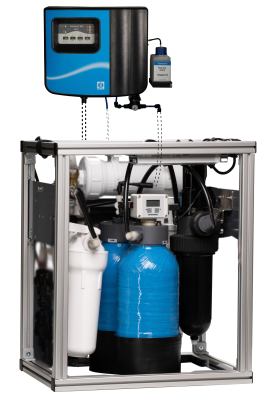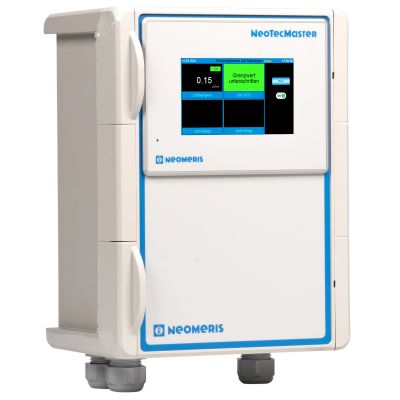Demineralised process water: Water treatment systems for demineralised process water
Water treatment systems for demineralised water
Rittal cabinet systems
Avoiding contamination during downtime through permanent recirculation
In the modular treatment plant, the system components are located in two Rittal cabinets. Rittal is a leading company that manufactures cabinet systems. It provides a wide range of solutions that safely store and protect electronic components. Rittal cabinet systems are available in different sizes, designs and configurations and are suitable for a variety of applications such as telecommunications, power distribution, industrial automation and IT infrastructure.
Rittal offers high-quality, functional and flexible cabinet systems. They are constructed from robust sheet steel modules and have a first-class surface coating. Thanks to their robust construction, Rittal cabinets provide reliable protection for the devices they contain.
They are protected from dust, dirt, moisture, vibrations and other environmental influences. Rittal cabinet systems have a modular structure that allows them to be adapted to individual requirements and the available space. They offer numerous options for mounting accessories, including shelves, cable management, air conditioning systems and power distribution systems.
To prevent unauthorised access to the equipment and ensure data security, these cabinet systems also have various security features such as lockable doors, security locks and access control systems.
The modular water treatment systems from Heyl-Neomeris require a minimum floor space of 1.60 m x 1 m. It consists of two cabinets, each of which is 80cm wide and 60cm deep. It is possible to work with double doors. This results in an area of 1m in depth due to the depth of 60cm plus a double door with a dimension of 40cm.
HeylNeomeris as a supplier of under-sink systems for laboratories and medical practices
Since it can be integrated into a kitchen unit like a normal household appliance – it is rather small in terms of appearance, but a real giant when it comes to purity – it could easily be accommodated in a kitchen unit.
In our role as a supplier of water treatment technology, we are particularly well known for our expertise in disinfection and ultrapure water technologies. Our latest solution is ideal for meeting the demand for demineralised water in laboratories and operating medical practices, ensuring that the necessary equipment and instruments are available at all times.
Our new system concept can easily cope with the required limit values in accordance with guidelines 17 and 18 of the Hygiene, Construction and Technology Committee of the DGSV in the smallest of spaces. The demineralised water requirement is up to 50 litres/hour.
Hygiene and disinfection are of central importance to every surgeon. Our intelligent solution includes measuring the conductivity and silicates. As a system supplier, we help you to determine the demineralised water requirement and ensure problem-free integration. For an efficient process flow, trouble-free operation and a sustainable quality of devices and instruments are essential.
The under-counter version combines proven processes and a compact design to produce up to 50 litres of demineralised water per hour, while minimising the space required.
The value retention of the equipment and instruments used is taken into account and guaranteed by the continuous monitoring of the produced demineralised water with regard to the currently recommended limit values of the DGSV for conductivity and silicates. With integrated rinsing connections, the system can be used as required in buildings with low operating theatre utilisation.
Our under-counter system is always equipped with the Testomat 808 SiO2. In this case, the silicate measuring device is not installed in the system, but is mounted separately on the wall. The complete system with Testomat 808 SiO2 is shown on the left/right as a standard basic package.
Width: 55 cm
Depth: 40 cm
Height: 60 cm
Optimised work processes
Patient safety, cost savings, legal certainty and instrument maintenance
A demineralised water production system that is used as process water in the reprocessing process consists of several components*.
To optimise these workflows, professional guidelines recommend stricter limit values**. These new requirements are already being followed by many hospital management and AEMP managers in their process water production. This results in several advantages.
This not only provides legal security, but also immediate cost savings. Calcification, corrosion and silicate deposits, which are visible signs of poor process water quality, are less frequently encountered in medical instruments, washer-disinfectors and sterilisation units.
The hygienic risk of germs and contamination, which jeopardise successful sterilisation and thus patient safety, is reduced. The well-being of patients is probably the top priority for every medical institution, far ahead of economic considerations, which must of course be taken into account. Everyone who bears legal responsibility for patient safety and processes is responsible here***.
Only up-to-date water treatment in accordance with the latest state of knowledge provides legal certainty in the treatment process.
If we also consider the relief of the personnel in these considerations, we come to the conclusion that employee satisfaction increases due to improved workflows and the associated reduction in stress – a classic win-win situation.
Standard equipment of the plants:
Testomat® 808 SiO2 Silicate measuring instrument
A Testomat®808 SiO2 Silicate is used to carry out permanent silicate monitoring. The Testomat®808 SiO2 measuring instrument is used to measure the silicate content in water. The Testomat®808 SiO2 uses the molybdenum blue method as a measuring method. In this method, the silicate in the water comes into contact with a molybdenum-containing reagent solution. This reaction leads to the formation of a blue colour, the intensity of which correlates with the silicate content.
The colour intensity is measured by the instrument using an optical sensor. This is converted into a measured value that represents the silicate content of the water. The user interface, display and control elements, as well as connections for water samples and drainage, are contained in the compact housing of the Testomat®808 SiO2.
The Testomat 808®SiO2 ensures reliable compliance with the SiO2 limit value of 0.4 mg/l recommended by the DGSV and AKI. If a limit value is exceeded, it can be forwarded to the NeoTec-Master® (available as an option) or an optical warning element can be activated directly.
It is necessary to continuously monitor the silicate content in order to effectively prevent possible deposits and the resulting damage to equipment and instruments.
Companies have the option of continuously monitoring the silicate content using the Testomat®808 SiO2 and taking appropriate measures to prevent deposits if necessary.
The Testomat®808 SiO2 enables companies to continuously monitor the silicate content and, if necessary, take appropriate measures to prevent deposits.
Shut-off via system separator
It is essential to install a system separator to protect the drinking water network from contamination by treated water or changes in the natural composition of the drinking water fed in as a result of the technical treatment of the water.
An integrated system separator (type BA) is installed in the system, located directly behind the Aqua-Stop of the water connection.
Aqua-Stop (magnetic valve shut-off)
An Aqua-Stop is used in water supply systems to stop or restrict the flow of water in the event of a fault or leak. It is usually an automatic shut-off mechanism that is used to close the water supply valve to prevent serious water damage.
A solenoid valve is controlled by an electromagnetic field and is a form of shut-off valve. In water treatment, a solenoid valve is used to shut off or regulate the flow of water. A valve mechanism and an electromagnetic coil system are the components of the solenoid valve. A magnetic field is created when an electrical current is applied to the coil, which affects the valve mechanism. The solenoid valve can be opened or closed, depending on the application, to allow or block the flow of water. The combination provides additional security and monitoring of the water flow.
The first element behind the main water connection of the system is the Aqua-Stop. The corresponding solenoid valve has two sensors, each of which constantly monitors the floor pans of the two cabinet systems. The floor pans are an essential component of the cabinet systems.

